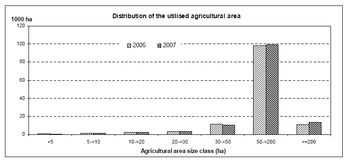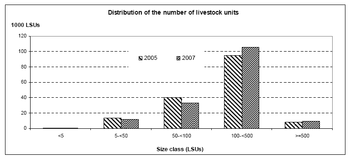Archive:Pig farming sector - statistical portrait 2014
- Data from 2008, most recent data: Further Eurostat information, Main tables and Database.
Pigmeat is produced throughout the EU on several types of farms with considerable variations from one Member State to another. Three quarters of the pigs are reared by just 1.5% of the largest fatteners. Small pig producers are mostly found in the new Member States and are one of the reasons for the decreasing size of the herd. The tasks of pig rearing are distributed across farms and, in the main production basins, even across regions.
Main statistical findings
Regional data on livestock are more informative than national figures as a means of displaying the zones of pig production (Figure 1). The major production basin extends from Denmark to Vlaams Gewest (BE) and accounts for 30% of EU sows. However, there are other important regions, such as Cataluña, Murcia (ES), Lombardia (IT), Bretagne (FR) and some areas of central Poland and Northern Croatia.
Structure of the pig farms
The distribution of national herds by size is taken from the Farm Structure Survey (FSS). The pigs arerecorded in three categories, i.e. piglets, breeding sows and other pigs. The sows reflect the permanent pigherd and the other pigs are the pigs fattened before slaughtering (see methodological notes).
Herd size: other pigs
The distribution of the pig population by size of the pig herds (in numbers of other pigs) shows that 1.5% of pig farms have at least 400 other pigs and manage 75.7% of these (Figure 2) and 49.1% of the sows. These figures conceal national differences: only 21.6% of other pigs in Poland are kept in such farms as compared to the figure of 90% or more in nine Member States (IE, CY, DK, EE, ES, IT, BE, UK and CZ). On the other hand, the animals kept in small units of less than 10 other pigs are important in RO (66.2%), BG (34.8%) and LT (31.9%). At the EU level, although these small units manage 5.3% of other pigs, they account for 85.8% of the pig farms.
Herd size: breeding sows
Two types of pig farm may be distinguished based on the number of breeding sows: the fatteners and the breeder-fatteners. Almost half of the other pigs (47.3%) are kept by fatteners, i.e. on farms without sows. However, this particular figure hides a range of different situations: 77.2% of the other pigs are reared by fatteners with more than 400 animals, whereas 95.7% of the fatteners have fewer than 10 pigs, mainly for own consumption. More than half of these numerous small farms (57.2%) are in Romania.
Breeding sows, other pigs and herd size
Besides the numerous small fatteners, the other pigs are shared between three further significant types of farm. Of the largest farms with at least 400 other pigs, the pure fatteners and the large breeder-fatteners with at least 100 sows manage similar numbers of other pigs and the large breeder-fatteners feed almost half of the sow herd. A third group accounts for a quarter of the pig farms and manages one fifth of the other pigs and the remaining half of breeding sows.
The breakdown of other pigs among the four types of pig farm (Table 1) is shown by country in Figure 3.
• The small fatteners (no sows and fewer than 10 other pigs) represent a significant share of pig production and at least 10% of other pigs in seven of the new Member States (BG, LV, LT, HU, RO, SI and SK). The importance of own consumption in pig production limits the sensitivity of this type of production to market conditions.
• The large fatteners (no sows and at least 400 other pigs) account for more than one third of other pigs in ten countries (BE, DK, DE, ES, IT, LU, NL, FI, SE and UK). They reflect a production organised between specialised breeders (which nevertheless have other pigs) and fatteners. These 10 countries represent two thirds of the other pigs and three quarters of the EU pigmeat production. In FR and EE the distribution is intermediate between that typical of large fatteners or large breeders.
• The large breeders (at least 400 pigs and 100 sows) manage more than two thirds of the other pigs in five countries (CZ, IE, EL, CY and PT), where production is concentrated in a less organised production sector.
• The other pig farms manage more than two thirds of other pigs in MT, AT and PL, which reflects a certain level of concentration, but one which is limited by the farm size. SI, with almost half of the other pigs in such farms, also belongs to this group of countries.
Data sources and availability
Due to the different coverage of the FSS across Member States, the total number of farms is not comparable between countries. This is why the present analysis, including Tables 1-4 and the graphs focus on holdings of at least one European size unit (ESU).
The survey on the structure of agricultural holdings in Luxembourg was carried out in May 2007 on an exhaustive base, by the Luxembourg Central Statistical and Economic Studies Office (STATEC) in collaboration with the 116 municipalities of the country and the Rural Economy Office (Service d'Economie Rurale -SER).
The agricultural census has been conducted yearly since 1953. The reference date of the FSS 2007 was the 15 May 2007, however for the farm labour force characteristics the reference period covers the 12 preceding months.
The FSS relates to holdings whose utilized agricultural area is one hectare or more and those whose area is less than one hectare but produce for sale (including livestock) or have at least 100 m2 of vineyard. The target population was all the farms with an operating base located in the Grand Duchy of Luxembourg. The list of holdings was updated and completed at municipality level prior to the census, data from the SER were also used to check the completeness of the population. Administrative sources from the SER were used to determine agricultural areas and livestock. The organic farming data were checked using data from the Administration of the technical services of agriculture in Luxembourg.
The data have been checked several times during processing: at municipality level (when collecting the questionnaires and when compiling the data) and then at a national level using software. The national data are checked against the municipal lists and tables from previous years. The no-response rate is not significant (0.5 %) and the missing data are imputed from previous surveys.
Between FSS 2005 and 2007 "maintaining land in good agricultural and environmental conditions" (GAEC) became an agricultural activity and the land concerned with this new activity has been included in the agricultural area. In Luxembourg it covers 260 ha, 96 % being in farms with at least one ESU.
For each activity (`enterprise`) on a farm (for instance producing wheat, dairy cow or vineyard), a Standard gross margin (SGM) is estimated, based on the area (or the head count of livestock) and a regional coefficient. The sum of such margins in a farm is its economic size, expressed in European size units (ESU). One ESU is equivalent to 1200 EUR SGM.
An 'annual work unit' (AWU) is equivalent to a worker employed on a full time basis for one year. In Luxembourg it is 2 200 hours (275 working days of 8 working hours per day) provided the person is between 15 and 80 years.
A 'livestock unit' (LSU) is equivalent to a dairy cow. The number of animals (number of heads) is converted into LSU using a set of coefficients reflecting the feed requirements of the different animal categories.
Context
European Commission Rural development policy aims to improve competitiveness in agriculture and forestry, improve the environment and countryside, improve the quality of life in rural areas and encourage the diversification of rural economies.
As agriculture has modernized and the importance of industry and services within the economy has increased, so agriculture has become much less important as a source of jobs. Consequently, increasing emphasis is placed on the role farmers can play in rural development, including forestry, biodiversity, the diversification of the rural economy to create alternative jobs and environmental protection in rural areas.
The FSS continues to adapt to provide timely and relevant data to help analyse and follow these developments.
Further Eurostat information
Publications
- Farm Structure Survey in Luxembourg - 2007 - Statistics in focus 96/2008
- National Methodological Report – FSS 2007 Luxembourg (available on request)
Main tables
- Agriculture, see:
- Structure of agricultural holdings (t_ef)
Database
- Agriculture, see:
- Structure of agricultural holdings (ef)
Dedicated section
- Agriculture, see:
- Ad-hoc tables: Farm Structure Survey







